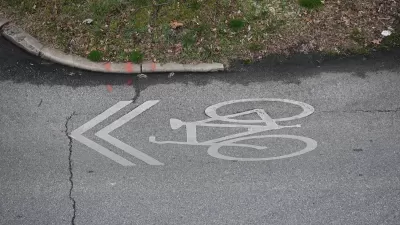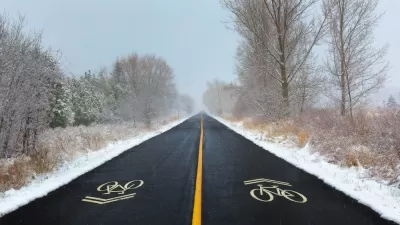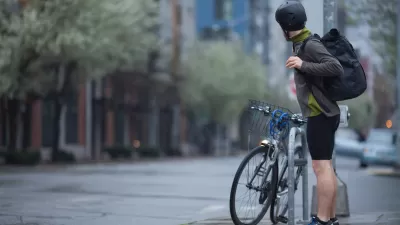Proliferating faster than bike lanes or bike parking racks may be the chevron symbols in the pavement with bicycle icon informing cyclists and motorists alike to "share the road". But can too many sharrows be a bad thing, asks Grist's Elly Blue.
Ms. Blue reports from Seattle where the sharrow has become somewhat ubiquitous since it was included in the 2007 Bike Master Plan.
"A 'sharrow' -- the word is an amalgamation of "arrow" and "share the road" -- is a larger-than-life thermoplastic symbol of a bicycle topped by two chevrons pointing the way forward.
Sharrows have been increasing in popularity nationwide, and got a boost in 2009 when they were officially entered into the federal transportation engineering canon.
Like many experts on transportation bicycling, Tom Fucoloro, proprietor of the Seattle Bike Blog, wasn't enthusiastic about them. Sharrows are spread so indiscriminately on Seattle streets, he said, that "they mean nothing now." He has noticed that there seems to be "slightly less aggression" from drivers when they're in place. "But does that mean all the streets without sharrows are worse?"
A 2004 study prepared by Alta Planning + Design for the San Francisco Department of Parking & Traffic "says sharrows slow car traffic slightly, and make bicyclists a little safer. But they are even better at keeping drivers at a distance from parked cars -- once again, bike infrastructure benefits more than just people on bikes."
From Seattle Bike Blog: Elly Blue's take on sharrows after a recent trip to Seattle: Tom Fucoloro describes his visit with "Elly Blue, a prolific bicycle writer and zine editor from Portland. Our conversation made its way to sharrows, which are the topic of her most recent story for Grist. Seattle's sharrows are a rather confused road marking, but legally, they don't do anything."
FULL STORY: BIKING Sharing time: Tracking the ‘sharrow’ on city streets

Trump Administration Could Effectively End Housing Voucher Program
Federal officials are eyeing major cuts to the Section 8 program that helps millions of low-income households pay rent.

Planetizen Federal Action Tracker
A weekly monitor of how Trump’s orders and actions are impacting planners and planning in America.

Canada vs. Kamala: Whose Liberal Housing Platform Comes Out on Top?
As Canada votes for a new Prime Minister, what can America learn from the leading liberal candidate of its neighbor to the north?

Washington State’s Parking Reform Law Could Unlock ‘Countless’ Acres for New Housing
A law that limits how much parking cities can require for residential amd commercial developments could lead to a construction boom.

Wildlife Rebounds After the Eaton Fire
Following the devastation of the Eaton Fire, the return of wildlife and the regrowth of native plants are offering powerful signs of resilience and renewal.

LA to Replace Inglewood Light Rail Project With Bus Shuttles
LA Metro says the change is in response to community engagement and that the new design will be ready before the 2028 Olympic Games.
Urban Design for Planners 1: Software Tools
This six-course series explores essential urban design concepts using open source software and equips planners with the tools they need to participate fully in the urban design process.
Planning for Universal Design
Learn the tools for implementing Universal Design in planning regulations.
Central Transportation Planning Staff/Boston Region MPO
Heyer Gruel & Associates PA
Institute for Housing and Urban Development Studies (IHS)
City of Grandview
Harvard GSD Executive Education
Regional Transportation Commission of Southern Nevada
Toledo-Lucas County Plan Commissions





























